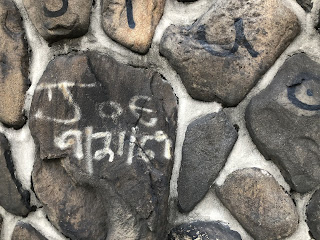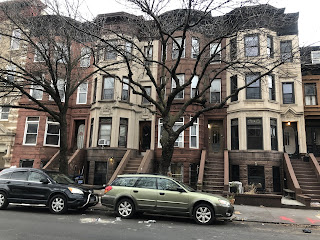Late yesterday, I zigzagged between Brooklyn and Queens on Tosca, my Mercian fixed-gear bike. I sometimes take rides like that with no particular destination, and turn wherever something looks interesting--or, sometimes, just to take the path of least resistance (less traffic, a better-looking road or just inertia). Rides like the one I took yesterday inevitably lead me along streets never frequented by hipsters or the bourgeoisie and never visited by tourists. Those streets are also among the increasingly-small number of byways not enclosed by towers built from beige Lego blocks, black metal bars and windows designed for people to look at, but not see themselves.
One such street--Borden Avenue--parallels the Long Island Railroad tracks in Hunter's Point, about five kilometers from my apartment. It's still an industrial area, and sometimes interesting graffiti-murals (like the lamentably-gone Five Pointz) can be found.
While pedaling along Borden, I chanced upon something I would have expected to see on Five Pointz but, surprisingly, graced a billboard.
I have to admit that I felt a bit of shame. Sojourner Truth, Alice Paul and Ida B. Wells are familiar names to me, but until yesterday, Mabel Ping Hua-Lee wasn't. All of them fought for human rights, specifically for women and people of racial "minorities." The sad part is that, among them, only Ms. Paul (who died in 1977) lived long enough to fully benefit from the legislation for which she fought.
Sojourner Truth was born into slavery and died decades before the 19th Amendment became law. Ida B. Wells lived to see it, but not the civil rights legislation of the 1960s. Ms. Ping Hua-Lee apparently (I'll explain) lived long enough to enjoy the right to vote and to be a benificiary of civil rights legislation--but it's not clear as to whether she could, or did, take advantage of those rights.
Ms. Lee was born in China but came to New York as a child when her father, a missionary of the Baotist church, was sent to take over a church in Chinatown. The neighborhood--now endangered as a result of pandemic--could just as well have had a wall around it. Back then, it was much smaller. Some people, especially the women, almost never left their homes because of the hostility they faced and, like Lee's mother, had bound feet that made walking difficult. And, in contrast to today (or, at least, say, a year ago, before the pandemic), tourists rarely visited, except to gawk.
Moreover, Lee's father was unusual, not only for being a minister, but because he was able to enter the United States at all. The Chinese Exclusion Act was passed about a decade and a half before he arrived, but a few people like him--diplomats and other educated professionals--were sometimes allowed to emigrate.
Lee quickly took to the educational opportunities available to someone of her intellect and talents. She attended Erasmus Hall Academy, whose alumni include Beverly Sills and Barbara Streisand and whose most illustrious dropout is Bobby Fischer. After graduating Erasmus, she would attend Barnard College and become the first Chinese woman to earn a PhD in the United States--in economics, from Columbia University.
What she is best known for is her leadership in the suffragist movements, especially her role in the massive 1912 march. Energized by these experiences, she wanted to return to China and spark a similar movement. But those plans were thwarted when her mother fell ill and her father died. Although she wasn't a minister, she became the director of his church and used her position as a platform to advocate for gender and racial equality. Interestingly, she believed that Protestant theology could be used to advance causes of social justice, knowing full well that one of the goals of the Chinese Exclusion Act was to help keep a white Protestant majority in the United States. Of course that, thankfully, failed: Most of the mass immigrations that came from southern and eastern Europe between 1880 and 1919 wasn't Protestant. (Catholics and Jews, oh my!)
Little is known about Mabel Ping-Hua Lee's later years. She is believed to have died in or around 1966. It's not clear as to whether she ever became a citizen--and, thus, whether she exercised the right to vote for which she fought!
Now, in case you were wondering: After I got home from my ride and ate some vegetarian nachos I made for supper, I did a Google search on Mabel Ping-Hua Lee. I often do such things after rides and, in the days before the Internet, I'd go to the library the first chance I got after riding. You might say that bicycling has caused me to continue my education!
.jpg)

















































